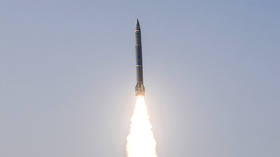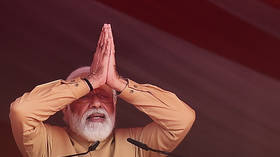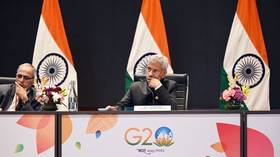Indian diplomats are upbeat on China, but predict problems with Pakistan

India’s Ministry of External Affairs (MEA) has published its annual report, summarizing the challenges it faces with each of its most significant neighbors — Pakistan and China — based on assessments of interactions with them in 2022.
The document’s focus is on New Delhi’s bilateral and multilateral engagements that primarily cast a critical eye on its neighborhood and is intended to set the tone and establish expectations for the year ahead.
The report, compiled by the MEA’s Policy and Planning Division, sounds the alarm about India’s nuclear-armed neighbor, Pakistan, and also elaborates on its “complex” relationship with China, both plagued by protracted border disputes.
India’s relations with both countries have been problematic, to say the least. There have been four wars with Pakistan: 1947-48, 1965, 1971 and 1999, all resulting in the comprehensive defeat of Islamabad. However, in a 1962 war with China, Beijing proved its military was superior to New Delhi’s.
Pakistan and terrorism
While the report mentions India’s desire for “normal neighborly relations with Pakistan,” it also accuses Islamabad of undermining the normalization of ties by supporting cross-border infiltration and ceasefire violations. A ceasefire agreement along the Line of Control in India’s troubled Jammu & Kashmir region, which Pakistan lays claim to, was signed in 2003.
However, it has been repeatedly violated by what New Delhi says are deliberate provocations by Islamabad, aimed at destabilizing India’s internal security. In 2021, nearly 700 ceasefire violations were reported up to October, according to the MEA report, resulting in the deaths of 37 civilians and 34 members of the security forces.
The report emphasizes India’s goal to address bilateral issues “peacefully in an environment free from terror, hostility and violence.” However, it also states that Pakistan does not respond like a “normal neighbor” as it continues to “sponsor cross-border terrorism; restrict normal trade, connectivity and people-to-people exchanges; engage in hostile and fabricated propaganda to vilify New Delhi and also to present an alarming picture of bilateral ties to the world.”
One specific accusation leveled against Pakistan is that Islamabad has not shown “sincerity in delivering justice” to the perpetrators of the 2008 terrorist attacks in Mumbai. The attacks, a four-day series of coordinated shootings and bombings which killed a total of 175 people and left more than 300 wounded, was carried out by groups that included 10 members of Lashkar-e-Taiba, a proscribed terrorist organization from Pakistan.
Islamabad has repeatedly denied New Delhi’s claims that it sponsors terrorism, recently accusing Indian officials of spreading “baseless propaganda”.
Ties that bind with China
The MEA report describes India’s ties with the country’s other major regional rival, China, as “complex”. It accuses Beijing of repeated attempts to “unilaterally alter the status quo along the Line of Actual Control in Western Sector since April-May 2020.” The border disputes with China are described as a matter that should be settled through diplomatic and military dialogue.
Tension at the border has not dampened trade between the two countries either. Between January and October 2021, “India-China bilateral trade totaled $102.29 billion, up 47.8% year-on-year. India’s exports to China reached $23.96 billion, up 38.20% year-on-year and India’s imports from China amounted to $78.33 billion, up 51% year-on-year. The trade deficit for the first 10-month period stood at $54.37 billion, up 56.95% year-on-year.”
Since the 2020 disturbances, the two sides have held over 20 diplomatic and military meetings in a dialogue which the report describes as a “candid and in-depth exchange of views,” and through which “the two sides will continue to sincerely work towards complete disengagement of the troops at all friction points,” according to the report.
China has likewise hinted at a willingness to improve ties with India and settle the border issues. In a January op-ed for the US magazine National Interest, China's new Foreign Minister Qin Gang wrote that “both sides are willing to ease the situation and jointly protect peace along their borders.”
Each party maintains that this is their stated position. Despite tensions between the Indian Army and Chinese People’s Liberation Army at border outposts flaring sporadically, they are largely brushed aside as “localized issues” that should not cast a shadow on bilateral diplomatic and trade ties.
The way forward
At international fora suchas the United Nations, Pakistan has been finding it increasingly difficult to internationalize the Kashmir issue, which is the nub of the hostile relations between the two neighbors. To make matters worse, the ties are likely to further worsen in the coming years because of a raft of internal issues in both countries.
India’s right-wing government, under Prime Minister Narendra Modi, has been championing hardline Hindu nationalism. Western media and commentators accuse him of “authoritarian rule” at the expense of the country’s largest minority, the Muslims — whose numbers as per the 2011 census stood at 14.2% of India’s population, or 172.2 million — the third-largest Muslim population in the world after Indonesia and Pakistan.
The religious angle under Modi has been a central talking point of Pakistani leaders. Besides, Islamabad, which has been plagued with political instability, corruption and constant one-upmanship between successive civilian regimes and the all-powerful Pakistani Army, deflects the domestic narrative from time to time by taking an aim at India.
Islamabad is good at ratcheting up bilateral tensions over human rights abuses against Muslims in Kashmir and beyond. The tactic has worked well at home, with the general Pakistani population often seeing India as an archenemy — a sentiment that is even evident when hosting a sporting event or when the two countries face off on a cricket field in a neutral venue.
With all this in mind, the current trend is likely to continue. Modi’s India evidently feels confident enough to continue antagonizing Pakistan and pushing forward with its nationalist policies in the disputed border regions, while Islamabad lacks the internal stability and international clout necessary to resist the pressure or enlist foreign assistance to push back.
On the contrary, Sino-Indian relations, which have gone through periodic peaks and troughs over the past 75 years, are best captured by reputed academician Kanti Prasad Bajpai in his book, “India Versus China: Why They Are Not Friends”, written after the Galwan clash in eastern Ladakh in 2020. He pointed out that “long-term conflict between the two sides is in terms of four Ps: perceptions of each other; quarrels over their perimeters, that is, the borderlands and Tibet; partnerships, each other’s main enemies; and a growing power-gap.”
This analysis summarizes a deficit of mutual trust. However, with the Indian MEA report pointing out record levels of bilateral trade and expressing optimism about continued dialogue on border disputes, it is evident that New Delhi and Beijing are willing to prioritize trade and commerce over the four Ps, which could be left on the backburner and dismissed as mind games or psyops.
The statements, views and opinions expressed in this column are solely those of the author and do not necessarily represent those of RT.















